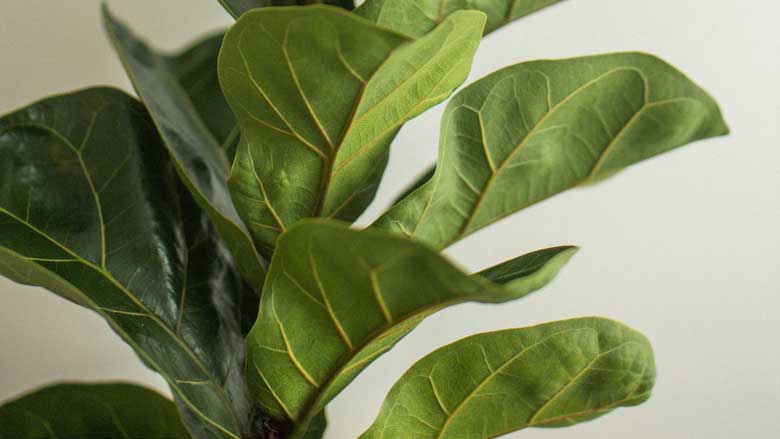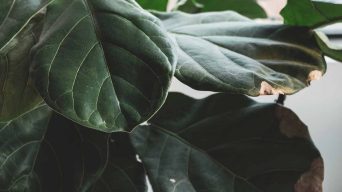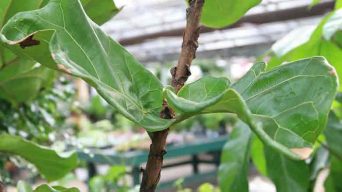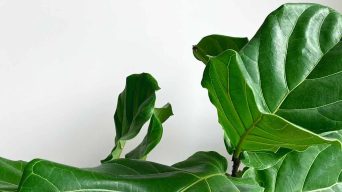Fiddle leaf figs (Ficus lyrata) are a popular houseplant known for their large, glossy leaves.
These plants can be challenging to care for, and one of the most common problems is overwatering.
Overwatering is often the result of too much water being given to the plant or insufficient drainage. This leads to several risks, including root rot, fungal diseases, and leaf drop.
To help you, we’ve put together this guide on identifying an overwatered fiddle leaf fig, what may be causing the problem, and what you can do about it.
What Are the Risks of Overwatering a Fiddle Leaf Fig?
Overwatering is a common problem with fiddle leaf figs. This is because the plant does not have a strong root system and is susceptible to root rot, killing the plant.
In addition, other risks can occur due to overwatering, including fungal diseases, bacterial diseases, pest infestations, and stunted growth.
Root Rot
Root rot is a common problem with overwatered fiddles.
It occurs when the plant’s roots are submerged in water for too long, which causes them to start decaying.
This can lead to several problems, including yellowing leaves, leaf drop, and stunted growth.
In severe cases, root rot can kill the fiddle leaf fig plant.
Fungal Diseases
Fungal diseases like powdery mildew and botrytis can also be problematic with overwatered plants.
Powdery mildew is a white powder that appears on the fiddle leaf fig leaves.
Botrytis is a gray mold that can cause the plant’s leaves to turn brown and rot.
These diseases can be challenging to control, and they can eventually kill the plant if left untreated. So, it’s crucial to monitor your plant’s moisture levels to prevent the development of white spots caused by these fungal infections.
Bacterial Diseases
Overwatered plants can also suffer from bacterial diseases such as bacterial leaf spot and bacterial blight.
Bacterial leaf spot is black or brown spots that appear on the fiddle leaf fig leaves. A yellow halo often surrounds the spots.
Bacterial blight is a disease that causes the plant’s leaves to turn brown or black and fall off. The stem may also turn brown or black and break easily.
These diseases are caused by bacteria in the soil or on the plant’s leaves. The bacteria can enter the plant through wounds in the leaves or stems.
Pest Infestations
Pests can also be problematic with overwatered plants. The moisture on the plant attracts pests.
The most common pests are:
- Aphids are small, winged insects that feed on the sap of plants.
- Mealybugs are small, wingless insects that feed on the sap of plants.
- Scale insects are small, wingless insects that attach themselves to the leaves of plants and suck out the sap.
- Aphids are small, green insects that feed on the plant’s sap.
- Mealybugs are white, fluffy insects that feed on the plant’s sap.
- Scale insects are small, brown insects that feed on the plant’s sap.
These pests can cause several problems, including stunted growth, yellowing leaves, and leaf drop.
Stunted Growth
Overwatering can also lead to stunted growth. This is because the plant’s roots cannot get the oxygen they need to function correctly.
The fiddle leaf fig tree may also be unable to absorb the nutrients it needs from the soil, leading to stunted growth.
You may also notice that the plant’s leaves are smaller than usual.
How Does Overwatering a Fiddle Leaf Fig Occur
Overwatering is most commonly caused by giving the fiddle leaf fig too much water. This can result from watering the plant too often or giving it too much water each time.
Fiddle leaf figs need to be watered about once a week.
The amount of water the plant needs will depend on the size of the pot, the type of potting soil, and the climate.
If you live in a hot, dry climate, you may need to water your fiddle leaf fig more often.
Another common cause of overwatering is poor drainage. This can occur if the pot does not have drainage holes or if the soil is too dense.
The water will not be able to drain properly and will start to pool around the plant’s roots, which prevents the roots from getting the oxygen they need.
This can lead to root rot and other problems.
In some cases, overwatering can also be caused by weather conditions. For example, the plant may get too much water if it rains excessively or has high humidity.
How to Identify an Overwatered Fiddle Leaf Fig
The fiddle leaf fig plant is a popular indoor plant known for its large, glossy leaves.
The plant is native to Africa and can grow up to 10 feet tall.
Fiddle leaf figs need to be watered about once a week. They should be allowed to dry out between watering.
When watering, give the plant enough water to drain out the bottom of the pot.
If you think your fiddle leaf fig is overwatered, there are a few things you can look for to be sure.
Signs of an Overwatered Fiddle Leaf Fig
An overwatered fiddle leaf fig tree can exhibit several different symptoms.
It’s essential to catch these early so you can take action to save your plant.
If you see any of the following signs, your plant is probably overwatered:
The Soil is Soggy
The first sign of overwatering is usually soggy soil.
If you stick your finger into the soil and feel wet, your fiddle leaf fig is getting too much water.
When the potting soil is soggy, the plant’s roots are not getting the oxygen they need to function correctly.
This can lead to several problems, including root rot.
There are Waterlogged Spots on the Soil
Another sign of overwatering is water-soaked spots on the soil.
These spots will be darker in color and will feel wetter than the rest of the soil.
Waterlogged spots are caused by water pooling on the soil surface. This can occur if the pot does not have drainage holes or if the soil is too dense.
The Fiddle Leaf Fig is Wilting
If your fiddle leaf fig is wilting, it’s a sign that it’s not getting enough water.
However, if the plant is wilting and the soil is soggy, it’s a sign of overwatering.
Overwatering prevents roots from getting the oxygen they need to function.
This causes the plant to wilt.
The Leaves are Turning Yellow or Brown
If your fiddle leaf fig leaves are turning yellow or brown, it’s a sign of overwatering.
When the plant’s roots are not getting enough oxygen and cannot take up nutrients from the soil, the leaves will turn yellow or brown.
However, it’s important to note that this can also be a sign of other problems, such as too much sun, pests, or diseases.
If you see this happening, it’s best to check the soil and see if it’s too wet or dry before making any decisions.
The Leaves are Falling Off
If your fiddle leaf fig leaves are falling off, it’s a sign that the plant is stressed.
Leaf drop can be caused by several things, including overwatering, pests, diseases, and too much direct sunlight.
If you see this happening, it’s essential to check the soil and see if it’s too wet or dry.
You should also look for other signs of stress, such as wilting or yellowing leaves.
The Soil is White or Fuzzy
If you see white or fuzzy patches on the soil, it’s a sign of mold growth.
The growth of mold can be caused by overwatering or poor drainage.
When the plant’s roots are constantly wet, they start to decay. This provides a perfect environment for mold to grow.
If you see mold on the soil, it’s crucial to take action immediately.
You should remove the affected soil and ensure the pot has adequate drainage.
The Plant Smells Bad
If your fiddle leaf fig smells bad, it’s a sign of rot.
When the roots of the plant are overwatered, they start to decay. This can cause a foul odor.
If you notice a terrible smell, it’s essential to check the plant’s roots.
If they are soft or mushy, it’s a sign of root rot.
Root rot can be fatal to your plant, so it’s crucial to take action immediately.
How To Save an Overwatered Fiddle Leaf Fig
If you think your fiddle leaf fig is overwatered, you can do a few things to save it.
Depending on the severity of the problem, you can save your plant with some simple changes.
Move the Plant to a Bright, Airy Location
If your fiddle leaf fig is overwatered, you should move it to an airy location with bright indirect light.
This will help the plant dry out and allow the roots to get the oxygen they need to function correctly.
Let the Soil Dry Out
If the soil is too wet, you must let it dry.
The best way to do this is to remove the fiddle leaf fig from the pot and let the soil dry out in a sunny location.
Once the soil is dry, you can replant the plant in fresh, dry soil.
Prune the Plant
If your fiddle leaf fig is severely overwatered, you may need to prune it.
Pruning will help to remove any dead or dying leaves and branches.
It will also help the plant to focus its energy on new growth.
Repot the Plant
If your plant is overwatered, you may need to repot it.
When repotting, use a pot with drainage holes and fresh soil.
Fiddle leaf figs need well-draining soil to thrive, so use a mix that drains well.
Check the Roots
If you think your fiddle leaf fig is overwatered, it’s essential to check the roots.
If the roots are soft or mushy, it’s a sign of root rot.
Root rot can be fatal to your plant, so it’s crucial to take action immediately.
The best way to check the roots is to remove the plant from the pot and examine the roots.
If you see any signs of root rot, such as black or mushy roots, you should remove the affected roots from the plant’s root ball.
After removing the affected roots, you should replant the fiddle leaf fig in fresh, dry soil.
How To Prevent Overwatering a Fiddle Leaf Fig Plant
You can do a few simple things to prevent overwatering a fiddle leaf fig plant.
Following these tips can help your plant stay healthy and thrive.
Use the Right Soil
When it comes to preventing overwatering, choosing the right soil is critical.
Fiddle leaf figs need well-draining soil to thrive, so use a mix that drains well.
You can add sand or perlite to your potting mix to improve drainage.
Use a Pot with Drainage Holes
When potting your plant, use a pot with drainage holes.
A drainage hole will allow excess water to drain from the pot and help prevent overwatering.
When watering your plant, water it slowly and allow the excess water to drain from the pot.
Don’t Water Too Often
One of the best ways to prevent overwatering is to water your fiddle leaf fig less often.
Fiddle leaf figs are drought-tolerant plants that don’t need to be watered often.
When watering fiddle leaf fig plants, let the soil dry out between waterings.
Although the watering frequency will vary depending on the season, plant’s size and location, a good rule is to water your fiddle leaf fig every 7-10 days.
Check the Soil Before Watering
Before watering your plant, it’s essential to check the soil.
If the soil is dry, your plant probably doesn’t need to be watered.
To check the soil, stick your finger into the potting mix.
If the soil is dry, you can water your plant.
If the soil is moist or wet, it’s best to wait until it has dried out before watering your fiddle leaf fig again.
Use a Moisture Meter
If you’re unsure whether your fiddle leaf fig needs to be watered, you can use a moisture meter.
A moisture meter is a tool that measures the moisture content of the soil.
To use a moisture meter, insert the probe into the potting mix and wait for the reading.
Your plant needs to be watered if the reading is below 50%.
If the reading is above 50%, it’s best to wait until the soil has dried out before watering your plant.
Final Thoughts
Overwatering is a common problem for Ficus lyrata, known as fiddle leaf fig plants.
Fortunately, you can do a few simple things to prevent and treat overwatering.
Using the right soil, watering your plant less often, and checking the soil before watering can help your plant stay healthy and thrive.
If you think your plant is overwatered, check the roots.
You should take action immediately if you see any signs of root rot, such as black or mushy roots. Remove the affected roots and replant the plant in fresh, dry soil.
Following these tips can help your fiddle leaf fig tree get back on track and stay healthy for years.







